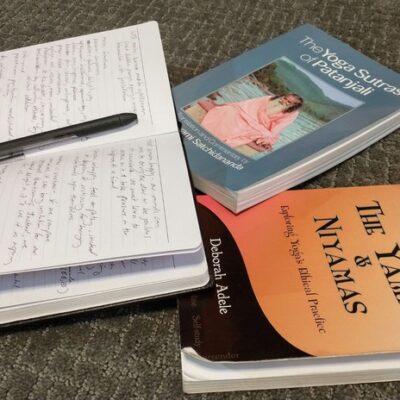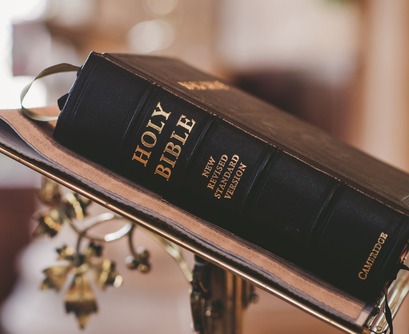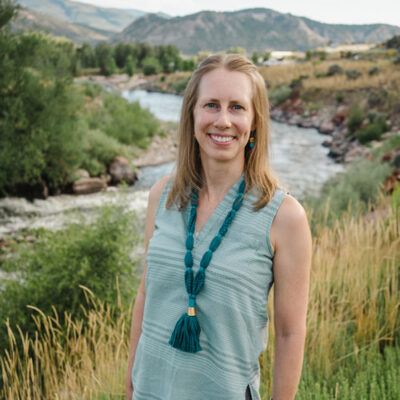Language shapes our view of the world. The definitions that we hold about words reflect how we see the world. I was just reminded the other day how just by adding the word ‘than’ completely changed the meaning of a sentence. Changing a ‘but’ to an ‘and’ in a sentence is a simple yet powerful way to go from negation to inclusion. When reading spiritual texts, what we are actually reading are translations from ancient languages and these translations shape our understanding. I’ve learned over the years to explore definitions because of this, especially when I’m feeling stuck.
SVADHAYA – SELF-STUDY
I’ve been studying the Bhagavad Gita for about 10 years. Each time I open it, I gain a new understanding of myself and the world from a spiritual perspective. This happens with any spiritual text that’s stood the test of time. They aren’t typical books that are read and then put back on the shelf. They are meant to be reviewed over and over, guiding us where we are at and providing deeper meaning over time.
 Traditionally, reading spiritual texts and scriptures are an important aspect of Yoga that’s been lost in the westernization of Modern Yoga. Yoga teachers have, typically, brief encounters with Patanjali Yoga Sutras and the Bhagavad Gita in their teacher training. Then most don’t ever open those books again or continue their study with them.
Traditionally, reading spiritual texts and scriptures are an important aspect of Yoga that’s been lost in the westernization of Modern Yoga. Yoga teachers have, typically, brief encounters with Patanjali Yoga Sutras and the Bhagavad Gita in their teacher training. Then most don’t ever open those books again or continue their study with them.
Those who have joined my 8-week session to take a deeper look at the Yamas and Niyamas, a part of Patanjali Yoga Sutras, are always amazed at the depth of the wisdom in this ancient text and its relevance to their life. What was written thousands of years ago can still guide those of us who want to gain a deeper knowledge of self and live a more spiritual life. This still blows my mind to think about!
MY CHALLENGE WITH ‘GOD’
One of the most challenging definitions for most Western-minded Yoga students, including myself, when studying Yogic texts is with the word ‘God.’ I don’t know about you, but this word used to be so loaded and reactive for me. My life experience with ‘God’ was a confusing one.
On one hand, I grew up in a progressive, Mennonite house-church. I remember it being a supportive, loving environment. There was never any dogma preached to me as a child that I remember. The adults took turns leading and looking back, it was more like a Sangha (spiritual community) than a traditional church. Exploration was encouraged.

Photo by Pixabay on Pexels
On the other hand was my exposure to my dad’s side of the family, who were closely involved in their church. Visiting them, I felt a lot of judgment around what was ‘right or wrong,’ ‘good or bad.’ When I used to hear the word ‘God,’ I would recoil. I wanted nothing to do with the ‘God’ of my extended family or the religious practices of my extended family. There was no ‘love’ from it…only fear.
YOGA ENCOURAGES EXPLORING DEFINITIONS
When I started to dive deeper into Traditional Yoga and ‘God’ was referred to often, I had to find a different definition in order to understand what was actually being said. This first exploration and change of definition with ‘God’ was to ‘Universe.’ Thinking of the vastness of the universe that is bigger and more knowing than I could ever be helped me open up to the spiritual teachings in the Bhagavad Gita.
After a bit, I started to change my definition again to ‘Divine.’ The word Divine felt connecting and supportive. So, I used the words Divine and Universe interchangeably. I could begin to understand that I am, at my essence, a Divine being, connected to the Divine of the Universe, which has always supported me.
Then, I started to notice that the word ‘God’ stopped being a word I was adverse to. God meant Divine and Universe, not an entity that was judging. It felt freeing! I would not have been able to do this without exploring definitions.
SEEING THE DIVINE IN EVERYONE
One concept in the Bhagavad Gita that I love the idea of but wasn’t able to put into practice fully comes from verse 6.29 which says that a person who is truly connected to Me/God/Supreme Self, sees That in all beings. Reading this, I was like ‘I want that! I want to see the Divine in everyone.’ I could imagine it feeling so connecting and full of love, without judgment or negativity.
 But it wasn’t easy to actually do. I kept coming back to it, contemplating it. Then, I came back to exploring definitions. ‘Seeing the Divine within’ was tripping me up. I knew that ‘seeing’ didn’t mean literally viewing with my eyes but it being more of an inner knowing or feeling. I was able to rethink myself towards this concept most of the time, but that wasn’t ‘seeing.’
But it wasn’t easy to actually do. I kept coming back to it, contemplating it. Then, I came back to exploring definitions. ‘Seeing the Divine within’ was tripping me up. I knew that ‘seeing’ didn’t mean literally viewing with my eyes but it being more of an inner knowing or feeling. I was able to rethink myself towards this concept most of the time, but that wasn’t ‘seeing.’
One day, I looked at the word ‘Divine’ and asked myself ‘what does this word really mean to me.’ The Divine isn’t something I can see with my eyes, so how do I know it? How do I define it? Immediately came the words love and peace. I could feel those words. Yes! The Divine is love and peace.
Now I had a more practical practice that made sense to me. When being with others, connecting to the love and peace they are working towards, even if unknowingly, helps me see them in a more broad, spiritual sense. Or, when it’s difficult, feeling these two words as I look at others. This shift has moved me closer to an understanding of the wisdom of this verse.
EXPLORE DEFINITIONS TO MOVE FORWARD
I share all of this to encourage you to start noticing how definitions might be influencing your reactions and behaviors. If you don’t like the reaction then explore different definitions and see what happens to the reaction.
In the end, words are just a compilation of letters, which are written forms of sounds. Our definitions are perspectives of those sounds. It’s the perspective that creates our suffering, not the actual sound, letters, or words.
Namaste.
 P.S. Have you reached midlife struggling with managing your emotional reactions, feeling a desire for more in your life, and realize the time to do it differently is now? Understand what may be keeping you from moving forward and the process that has helped me and the women I’ve worked with over the past decade in my free masterclass.
P.S. Have you reached midlife struggling with managing your emotional reactions, feeling a desire for more in your life, and realize the time to do it differently is now? Understand what may be keeping you from moving forward and the process that has helped me and the women I’ve worked with over the past decade in my free masterclass.

